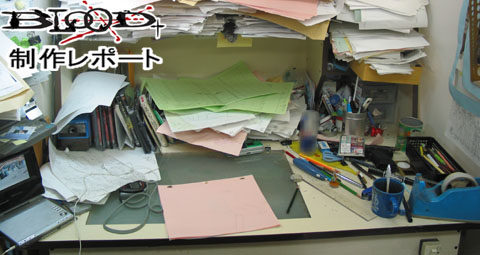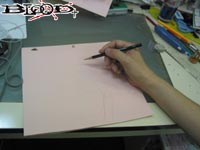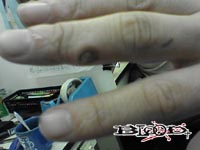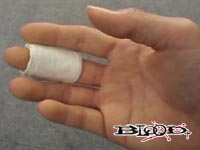Blood+ Production Report (2): Animation Direction

Hi, I'm Peko, a new recruit at the public relations section.
Last time, I went to check the script reading process. In this second part of my production report, I will focus on the drawing process, which is the highlight of any animation production! The drawing work is the process of creating pictures. It covers several jobs; for example, animation direction, key art, and in-between animation (1).
And today, I am going to interview the most important person in this whole process.
Chief Animation Director (2), Akiharu Ishii (3)!
Hello, Mr. Ishii!
 | Hello. |
Your desk (see top photo) - it's virtually like a battlefield of its own. (lol)
 | Yeah, it sure is messy. I don't particularly want to show it off to people. You know, it would have been perfect if I had a tidy desk with a piece of drawing lying on it with me gracefully drinking black tea and listening to classic music while working with it. (lol) |
No, to the contrary. It perfectly speaks to us, "this is our world"! Sweet!
 | You know, I used to have a cello right beside my desk until recently, and that sure made it feel like that. We used it for drawing. (lol) |
Changing the subject, I think I am correct in saying that the animation drawing is basically done by hand. Do you pay particular attention to the pencils you use?

 | I usually use F and H pencils. The leads are a bit harder. I draw thin lines, so I use those harder lead pencils and I sharpen them often too. (lol) |
For sure we all noticed that the lines are beautifully thin in Blood+! Is this because you like it that way?
 | It's not a matter of personal taste or some obsession of mine. I do it maybe because people who work in the later processes can pick-up the lines easily. My job as animation director consists in correcting the drawings made by the key animators, in order to keep the style homogeneous. If I modify other staff members' drawings with broad lines, they would tend to get confused, being unable to understand which line should be kept as reference. If the lines are thin, everything becomes clearer, don't you agree? (lol) |
Now I see! It's all because of your realistic and kind consideration towards others! In the case of thin lines, I heard some artists use mechanical pencils. How about you?
 | I'd rather use pencils. I once tried to use those mechanical pencils, but did you know that they don't actually have pointed tips? (lol) |
Really?
 | Yep. That's because you can't sharpen their tips. They won't get sharper than the lead size. And I feel the lines tend to look rigid. Not smooth enough. Hmm, it's difficult to explain. (lol) Anyway, I can obtain thinner and more brilliant lines if I thoroughly sharpen hard H or F pencils. But I put a lot of pressure when I draw, so I get sore shoulders and wrists... (lol) |
Isn't that what you call tendonitis? Are you all right?
 | It's not that serious. I have stiff shoulders and my fingers get numb sometimes. It might be a frozen shoulder due to age. (lol) I also have a pencil callus. (lol) |
I guess animators chronically suffer from pencil calluses.
 | I get a callus on an odd place; different from other people. I might be holding pencils the wrong way. That must be it. (lol) |

Yours is at the second joint! That's certainly a little off, isn't it? Is there anything you do when it gets painful?
 | I wrap the finger with tissue paper. Round and round. Then I hold a pencil to draw. When I do that, the pain is not that bad. (lol) |

Really? Isn't it awkward to hold a pencil like this?
 | You said it! But it's much better than not being able to draw because of the pain. |
Wow, that's what I call professionalism! Well, I will be asking more about the "character setting" process next time! Hope you will like that too.
NOTES
(1) The actual work of the drawing process can roughly be divided into "animation direction," "key animation" and "in-betweens." Animation supervisors try to make the entire animation flow smoothly. He or she actually supervises the animation. Key animators are responsible for the layout of their "cuts" and they also draw key images (usually the beginning and the end of each movement.) In-betweeners draw the animation between the key drawings.
(2) Chief animation director is a position that is created often for long TV productions such as Blood+. In a TV series, animation directors supervise each episode and the chief animation director oversees them and supervises the entire series.
(3) Akiharu Ishii was born on August 9, and he's obviously the super artist who has the title of chief animation director in the TV series Blood+.
Akiharu Ishii's Essential Filmography:
1989 - Patlabor: the Movie (key animator)
1993 - Patlabor 2: the Movie (key animator)
1994 - Blue Seed (key animator)
1995 - Ghost in the Shell (key animator)
2001 - Sakura Wars: The Movie (animation director)
2003 - Chains & Rings / Tsepi i kol'tsa (character design / animation director)
2005 - The Prince of Tennis: Two Samurai - The First Game (animation director)
2006 - Blood+ (chief animation director)
...and many more!
But it is said that he just likes drawing cute characters!
(2 - to be continued)
© 2005 Production I.G · Aniplex · MBS · HAKUHODO

![WORK LIST[DETAILS]](/contents/works/design/images/left_title.gif)



 terms of use
terms of use